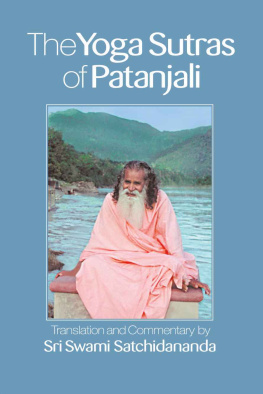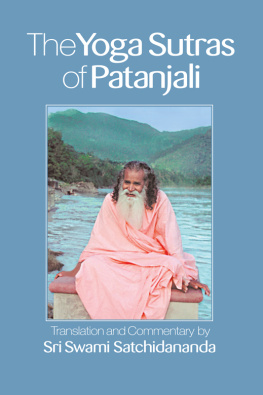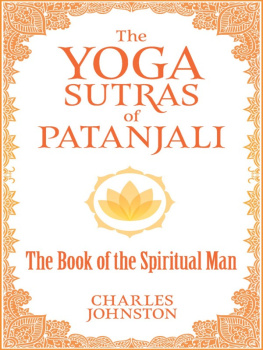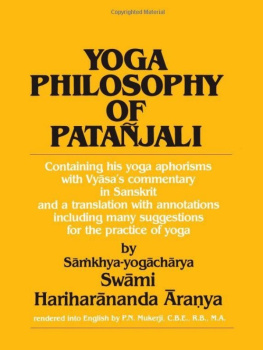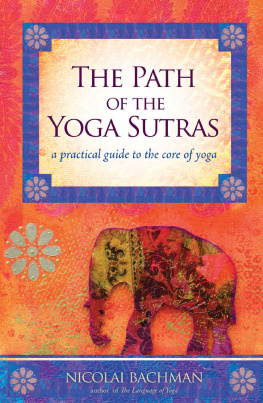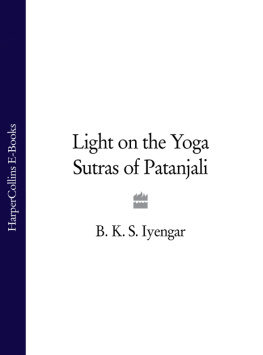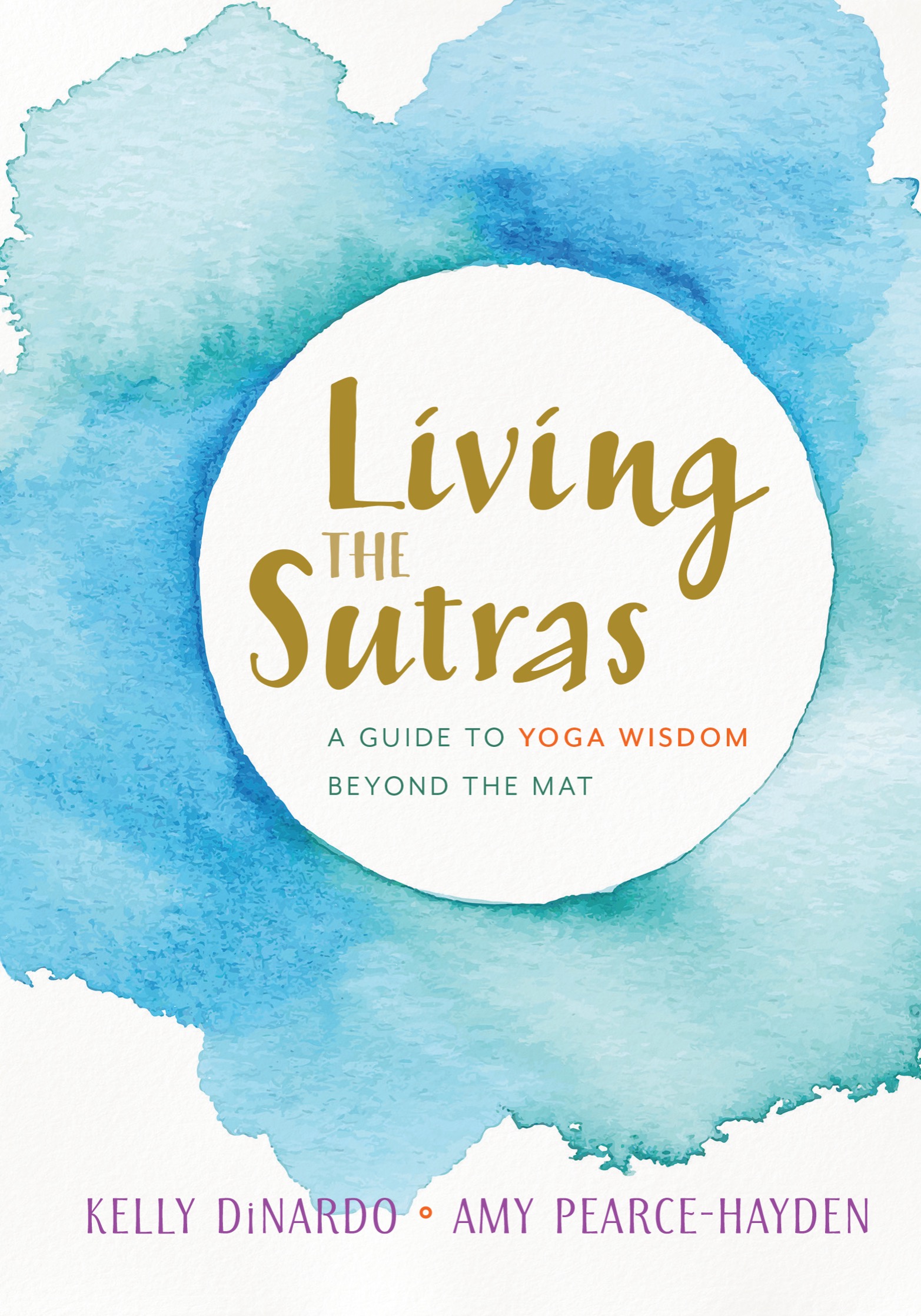Shambhala Publications, Inc.
All rights reserved. No part of this book may be reproduced in any form or by any means, electronic or mechanical, including photocopying, recording, or by any information storage and retrieval system, without permission in writing from the publisher.
eBook design adapted from printed book design by Gopa & Ted2, Inc.
Cover design: Gopa Ted2, Inc.
Names: DiNardo, Kelly, 1976 author.
Title: Living the sutras: a guide to bringing yoga wisdom to life / Kelly DiNardo and Amy Pearce-Hayden.
Description: Boulder: Shambhala, 2018. | Includes bibliographical references.
Subjects: LCSH : Patajali. Yogastra. | Hatha yoga. | Yoga. | Mind and body.
| Self-care, Health. | BISAC : HEALTH & FITNESS / Yoga. |
PHILOSOPHY / Hindu. | SELF - HELP / Spiritual.
Classification: LCC RA 781.7 . D 548 2018 | DDC 613.7/046dc23
INTRODUCTION
Now We Begin
M IND . B ODY . S PIRIT . In yoga, we explore all three, and on the mat, we get a glimpse that there is more to the practice than pretzel-like twists and gravity-defying balances. In your hands, you hold a mind and spirit companion to the physical practice.
Living the Sutras is a modern, accessible interpretation of ancient philosophy with exercises and writing prompts to help you make it alive, active, and applicable to your life. It is based on The Yoga Sutras, teachings compiled by the guru Patanjali roughly two thousand years ago. The sutras are a map for how to navigate through the challenges of human life. They contain lessons on how to deal with loss, pain, dissatisfaction, and alienation. And they provide guidance on how to cultivate joy and lead a healthy, happy, fulfilling life.
Its challenging to unfold this map when were working to keep our knee over our ankle in Crescent Pose or struggling to understand how ancient yogic wisdom could possibly help us deal with a difficult boss, an irritating sibling, or a rough patch with our partner. And this may be why the sutras are sometimes seen as dense, incomprehensible, or irrelevant to modern life.
This was certainly how Kelly felt about the sutras for many years. After a brief introduction to them during one yoga training, she tucked her translation onto a bookshelf where it, and the ideas within, grew dusty. Twelve years later, perched on a block at the front of her mat, she listened to her instructor Amy give a brief talk about viveka, or discernment. In her classes, and later over coffee, Amy made the sutras understandable, relevant, and personal to Kelly for the first time. This guide grew out of those conversations.
Its important to note that this is not an academic study, a scholarly examination, or a Sanskrit lesson. Rather, it is an offering to those who feel there is more to the practice of yoga. If our time on the mat is an opportunity to feel where we are in our body and in our physical life, then this is a chance to take our practice off the mat and to learn where we are in our mind and spirit. It is a way to interact with the ancient philosophy in an active, modern way. Its a guide for understanding how the mind works and an opportunity to refocus our attention so we can be present. It is a wayjust one wayto live the idea that yoga is a work in, not just a workout.
So what is the work in? What is the more of yoga?
In the simplest terms, the more of yoga is a life of ease, contentment, and purpose. The Yoga Sutras, introduced by Patanjali, is a systematic approach for how to achieve that. Beyond legend, little is known about the author or even if he was a single person or several people. Patanjali did not create yoga; he collected existing beliefs, ideas, and practices from various spiritual philosophies, organized them, and codified them into a step-by-step process for self-realization.
The Yoga Sutras are comprised of 195 compact sentences that are divided into four portions or books (padas). Patanjali first explains what yoga is, what a steady mind looks like, and the various obstacles that keep us from maintaining balance. In the second book, he presents the tools and practices that support the goal of yoga. In the remainder of the sutras, Patanjali describes in great detail the transformation that leads to the full and complete understanding of our true self and potential. This yogic system promises:
That the mind becomes steady and clear through practice.
That through these practices, we learn to minimize distractions and increase our awareness and presence in everyday life.
Greater understanding and acceptance of ourselves, others, and the world around us. This greater understanding connects us to our divine light and teaches us how to reach our potential and live with purpose. And, with others, we are able to communicate more clearly and understand their words and actions so our relationships are more harmonious.
Freedom from our fears, self-imposed limitations, and expectations. Classically, Patanjali talks about removing our limitations to such a degree that we are completely free, even of our own physicality, and we could gain superpowers like levitation, invisibility, and supernormal hearing.
We take a less Superman-like approach and believe Patanjali was inviting us to go beyond what we perceive is possible and to realize that we possess greater capability, knowledge, and potential. He is telling us that when we get ahold of our mind and silence the chatter, we will hear the true voice within, understand our spirit, function free of limitations, and be able to do anything.
If this seems ambitious, it is. Our goals are grand: wisdom, personal insight, freedom, a life of ease. As Sri Swami Satchidananda says in his translation and commentary of The Yoga Sutras: Never, never settle for these little things. Our goal is something very high. It is eternal peace, eternal joy. Dont settle for a little peace, for a little joy, for petty happiness.
There are hundreds of translations and commentaries on The Yoga Sutras, and we list some of our favorites in appendix 1, but Living the Sutras is something different. The sutras were written for a renunciate living in solitude thousands of years ago, and it is challenging to build a bridge between the ancient theory and the modern-day application. We hope that Living the Sutras will be your bridge.
This book can be used in many ways and at different times in your life and practice. It can be an introduction to this classical philosophy. It can be a quick guide and reference for students and teachers. But our aim is for you to make it part of an active self-study by using a journal, the writing prompts, and exercises to bring the ancient wisdom of the sutras into your life as a part of your practice. To do this, you might choose to read it from beginning to end to help you understand the yogic system and to support your personal journey. Or you may let chance give you focus and reflection for the day by randomly choosing a single commentary and prompt. However you choose to use this guide, we hope you find it to be an opportunity to actively engage with the sutras in a deeply personal way.


